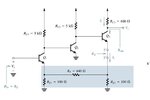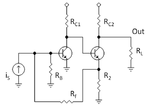Follow along with the video below to see how to install our site as a web app on your home screen.
Note: This feature may not be available in some browsers.
Hi everyone, the title is self-explenatory.
What does "type of feedback" refer to?
Should we understand it e.g. according to the chapter "8.4 feedback configurations" in Gray, Hurst, Lewis, Meyer, Analysis and Design of Analog Integrated Circuits?
The text book distinguishes series-shunt, shunt-shunt, shunt-series and series-series configuration. A similar scheme in German literature distinguishes voltage/current controlled voltage and current feedback.
Sorry guys, apparently I was too vague.
Let me rephrase then
Basically, I want to know if someone can teach me or share how to identify which type of negative feedback amplifier structures, either resistive or capacitive. That is, identify series-shunt, shunt-shunt, shunt-series and series-series configuration in negative feedback amplifier.
I have difficulty in identifying what type of feedback amplifier I am presented to.
BR
Does the "name" of feedback matter?
A common-emitter transistor can have an unbypassed emitter resistor or it can have a resistor from its collector to its base. They both create negative feedback and I have used them in designs hundreds of times without caring about what are their names.





The negative feedback from the output cancels some of the input signal which reduces the input impedance.But how did you identified, for example, that in the third circuit you have current feedback?
There is a capacitor in series with the negative feedback resistor that passes AC but blocks DC. AC feedback affects only AC signals and has no effect on DC. DC feedback stabilized the DC operating condition so that hFE changes or temperature changes do not have much effect on the DC.In addition to this, if I may ask, what's the difference between the AC feedback and the DC feedback? What's the implication? How did you identify that?
What's the benefit of AC feedback? In the case of the DC feedback it affects only the DC for example the op point. What about the AC? Affects the AC but how? What? What's the purpose of it?
Electronics knowledge, experience and common sense.How do you identify the type of feedback topology?
The problem might be that you don't hear.Still, the question was not answered